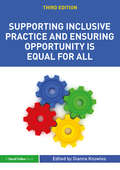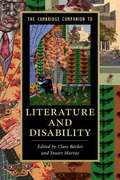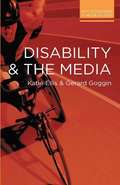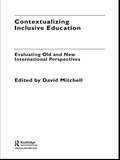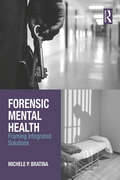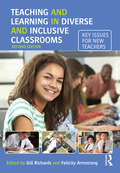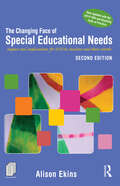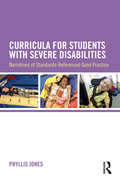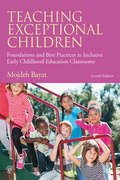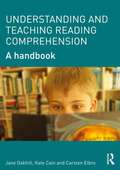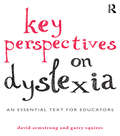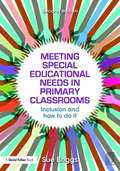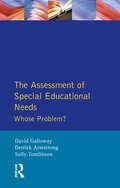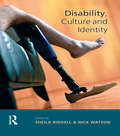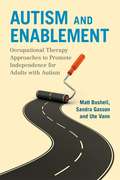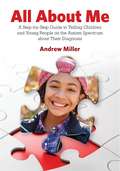- Table View
- List View
Supporting Inclusive Practice and Ensuring Opportunity is Equal for All
by Gianna KnowlesThis third edition of Supporting Inclusive Practice builds on the successful format of the previous two editions, both in content and structure. It explores many aspects of inclusive practice relevant to those who work with children in schools and other educational settings, aiming to provide the most up-to-date theoretical knowledge and understanding in the field, and illustrating the theory with examples of good practice in the areas explored. Many of the topics that have appeared in the previous editions, including supporting children for whom English is a second language, children on the autistic spectrum and children with neurodiversity conditions, also appear in this edition. The revised content of this third edition also covers recent and relevant changes in national policy and legislation, particularly, for example, around changes in equality and disability, same-sex parenting and transgender children and parenting policy and legislation. It explores the impact on aspects of inclusive practice legislation such as the Equality Act 2010, Marriage (Same Sex Couples) Act 2013 and the Children and Families Act 2014. It also explores in detail the revised 2014 SEN Code of Practice and the introduction of the pupil premium in 2011, which provides support for the education of children from low income families or who may be children who are fostered or in care. Throughout, the book is informed by the solution-focused social model of special educational needs and disability, and reflects current national policy that sees inclusive practice as fundamental to ensure equality of educational opportunity is achieved for all children.
The Cambridge Companion To Literature And Disability (PDF)
by Clare Barker Stuart MurrayThis Companion analyzes the representation of disability in literatures in English, including American and postcolonial writing, across all major time periods and through a variety of critical approaches. Through the alternative ideas of mind and embodiment generated by physiological and psychological impairments, an understanding of disability narrative changes the way we read literature. With contributions from major figures in literary disability studies, The Cambridge Companion to Literature and Disability covers a wide range of impairments, including cognitive difference, neurobehavioral conditions, and mental and chronic illnesses. This book shows how disability demands innovation in literary form and aesthetics, challenges the notion of a human 'norm' in the writing of character, and redraws the ways in which writing makes meaning of the broad spectrum of humanity. It will be a key resource for students and teachers of disability and literary studies.
Disability And The Media (PDF)
by Katie Ellis Gerard GogginMedia is a significant part of contemporary society and culture, and is subsequently crucial to our understanding of disability. How exactly does the media interact with disability and vice versa? Does the media adequately reflect the lives of people with disabilities or offer a means of social inclusion? Does the media perpetuate stigma or deny access to those with disabilities? This concise, integrated introduction to the complex relationship between disability and the media offers a road map to the key areas of participation, access and representation. Bringing together international theoretical work and research on disability, with analysis and examples across a diverse range of media forms - from radio, to news, popular television and new digital technologies - the text explores the potential for establishing a more diverse, rich and just media. It is an invaluable resource for students of Media and Communication Studies, Cultural Studies and Disability Studies.
Contextualizing Inclusive Education: Evaluating Old And New International Paradigms (PDF)
by David R. MitchellInclusive education is a complex and problematic concept that raises many questions. A team of prominent academics present fresh and critical perspectives on these issues, drawing upon their global resources and knowledge. The over-arching theme of this book is that social, political, economic and cultural contexts play a central role in determining whether or not inclusive education is implemented in a range of regions and countries around the world. A series of original and provocative conclusions is presented, such as: inclusive education means creating a single system of education, which serves all children inclusive education is a site of conflicting paradigms of children with special needs, centering on a psycho-medical model and a socio-political model while many countries seem committed to inclusive education in their rhetoric, legislation and policies, in practice this often falls short. This major landmark resource is suitable for educational policy makers, researchers, teacher educators, students and international agencies with interests in education.
Forensic Mental Health: Framing Integrated Solutions
by Michele P. BratinaForensic Mental Health: Framing Integrated Solutions describes a criminal justice–mental health nexus that touches every population—juvenile and adult male and female offenders, probationers and parolees, the aging adult prison population, and victims of crime. In the United States today, the criminal justice system functions as a mental health provider, but at great cost to society. The author summarizes the historical roots of this crisis and provides an overview of mental illness and symptoms, using graphics to illustrate the most prevalent disorders encountered by police and other first responders. Bratina demonstrates in detail how the Sequential Intercept Model (SIM) supports integration of the U.S. healthcare and justice systems to offer more positive outcomes for offenders with mental illness. This book takes a multidisciplinary approach, addressing social work, psychology, counseling, and special education, and covers developments such as case-law related to the right to treatment and trauma-informed care. Designed for advanced undergraduates, this text also serves as a training resource for practitioners working with the many affected justice-involved individuals with mental illness, including juveniles, veterans, and substance abusers.
Forensic Mental Health: Framing Integrated Solutions
by Michele P. BratinaForensic Mental Health: Framing Integrated Solutions describes a criminal justice–mental health nexus that touches every population—juvenile and adult male and female offenders, probationers and parolees, the aging adult prison population, and victims of crime. In the United States today, the criminal justice system functions as a mental health provider, but at great cost to society. The author summarizes the historical roots of this crisis and provides an overview of mental illness and symptoms, using graphics to illustrate the most prevalent disorders encountered by police and other first responders. Bratina demonstrates in detail how the Sequential Intercept Model (SIM) supports integration of the U.S. healthcare and justice systems to offer more positive outcomes for offenders with mental illness. This book takes a multidisciplinary approach, addressing social work, psychology, counseling, and special education, and covers developments such as case-law related to the right to treatment and trauma-informed care. Designed for advanced undergraduates, this text also serves as a training resource for practitioners working with the many affected justice-involved individuals with mental illness, including juveniles, veterans, and substance abusers.
Teaching and Learning in Diverse and Inclusive Classrooms: Key issues for new teachers
by Felicity Armstrong Gill RichardsThis accessible text focuses on diversity in education and the inclusion of all children and young people in all aspects of the school or college community. It provides an introduction to policy, theory and practical strategies in relation to diversity in education for practitioners, researchers and policy makers. The fully revised and updated chapters discuss recent debates, research studies and current initiatives, particularly relating to teaching and learning, and conclude with key questions for student reflection. Topics include: Inclusive education ethnic and cultural diversity challenging behaviour bullying gender identity and sexuality Gypsy, Roma and Traveller children special educational needs listening to parents religious and cultural diversity disability and human rights children and young people who are refugees or seeking asylum Reflecting on legislative duties, personal values and the importance of listening to the voice of all learners, particularly those who may experience disadvantage or discrimination in educational settings, Teaching and Learning in Diverse and Inclusive Classrooms is a key resource for initial teacher training programmes and professional development courses.
The Changing Face of Special Educational Needs: Impact and implications for SENCOs, teachers and their schools
by Alison EkinsFully revised with the requirements of the 2014 new SEN Code of Practice, this second edition of The Changing Face of Special Educational Needs shows teachers, SENCOs and students in teacher training how to respond to the rapidly changing context of special education. This highly practical and accessible text unlocks the often confusing field of special education provision in schools today by: Summarising and clarifying new policy directions as they emerge, in light of the new SEN Code of Practice Suggesting clear, practical activities to bring the theory to life, helping practitioners to review and reflect upon their work; Encouraging critical reflection about existing systems within the school context, considering whether these will remain appropriate and ‘fit for purpose’; Giving opportunities for teachers, SENCOs and senior leaders to contextualise the new changes in terms of the implications for practice in their own school. Including a new chapter on Using Technologies to Support the Development of Inclusive Practices, this text is packed with activities, case studies and points for reflection. It will help the teacher, SENCO, senior leader or advisor to make sense of the rapid pace of change of policy and terminology related to SEN and supports readers in a positive way, emphasising the exciting opportunities that these changes will provide for developing new, innovative and creative working practices. This book will also be essential reading for all SENCOs completing the National Award for SEN Coordination.
Curricula for Students with Severe Disabilities: Narratives of Standards-Referenced Good Practice
by Phyllis JonesStudents with severe disabilities comprise 2 percent of the population of learners who are impacted by intellectual, communicative, social, emotional, physical, sensory and medical issues. Increasingly, however, teachers are required to meet the challenges of creating a pedagogical balance between an individual student's strengths, needs and preferences, and core academic curricula. The need to embrace the current initiative of curriculum state standards in the debate of curricula relevance, breadth, balance and depth for students with severe disabilities is not just timely—it contributes to the evolving debate of what constitutes an appropriate curriculum for severely disabled learners. Curricula for Students with Severe Disabilities supports the development of greater understandings of the role that state curriculum standards play in the pedagogical decision-making for students with severe intellectual disabilities. The book first discusses the nature and needs of these students, the curriculum for this group of learners and the recent contributions of state curriculum standards, before presenting narratives of real classrooms, teachers and students who have meaningfully integrated state curriculum standards at the kindergarten, elementary and high school levels.
Teaching Exceptional Children: Foundations and Best Practices in Inclusive Early Childhood Education Classrooms
by Mojdeh BayatTeaching Exceptional Children is an ideal textbook for introductory graduate and undergraduate courses on early childhood special education and teaching in inclusive classrooms. Bayat’s clear and accessible writing, a visually appealing design, and focused pedagogy in each chapter help make it possible to cover a significant amount of material. This powerful text identifies specific behavioral characteristics and presents theoretical information grounded in neuroscience and child development research for a wide range of disabilities. Research-based best practices for effectively working with children with various disabilities in inclusive classrooms are provided in each chapter. The second edition has been fully updated based on the DSM-5, and includes new sections on contemporary issues in inclusion of children with disabilities in early childhood classrooms, such as challenging behaviors, using technology, at-risk children, promoting mental health, and family issues. A robust pedagogical program, along with online resources for instructors and students, provides full support, including: Chapter Objectives and Key Terms help frame each chapter Discussion, Critical Thinking, Essay/Short Answer, and Review Questions at the beginning, throughout, and concluding chapters prompt students to fully engage with the material Homework/Field Assignments provide opportunities for students to apply their knowledge to real-world situations Real-Life Vignettes illustrate concepts in action Color Photos, Figures, and Tables clarify concepts in a visually engaging way Recommended Resources and References offer guidance for further study www.routledge.com/9781138802209 includes a link to an Instructor's Manual with ideas for assignments and projects, grading and assessment rubrics, and learning outcomes (see the e-Resource tab). A full companion website (www.routledge.com/cw/bayat) is under construction and will provide video and web links, discussion questions, test bank, PowerPoints, and a sample syllabus.
Teaching Exceptional Children: Foundations and Best Practices in Inclusive Early Childhood Education Classrooms
by Mojdeh BayatTeaching Exceptional Children is an ideal textbook for introductory graduate and undergraduate courses on early childhood special education and teaching in inclusive classrooms. Bayat’s clear and accessible writing, a visually appealing design, and focused pedagogy in each chapter help make it possible to cover a significant amount of material. This powerful text identifies specific behavioral characteristics and presents theoretical information grounded in neuroscience and child development research for a wide range of disabilities. Research-based best practices for effectively working with children with various disabilities in inclusive classrooms are provided in each chapter. The second edition has been fully updated based on the DSM-5, and includes new sections on contemporary issues in inclusion of children with disabilities in early childhood classrooms, such as challenging behaviors, using technology, at-risk children, promoting mental health, and family issues. A robust pedagogical program, along with online resources for instructors and students, provides full support, including: Chapter Objectives and Key Terms help frame each chapter Discussion, Critical Thinking, Essay/Short Answer, and Review Questions at the beginning, throughout, and concluding chapters prompt students to fully engage with the material Homework/Field Assignments provide opportunities for students to apply their knowledge to real-world situations Real-Life Vignettes illustrate concepts in action Color Photos, Figures, and Tables clarify concepts in a visually engaging way Recommended Resources and References offer guidance for further study www.routledge.com/9781138802209 includes a link to an Instructor's Manual with ideas for assignments and projects, grading and assessment rubrics, and learning outcomes (see the e-Resource tab). A full companion website (www.routledge.com/cw/bayat) is under construction and will provide video and web links, discussion questions, test bank, PowerPoints, and a sample syllabus.
Understanding and Teaching Reading Comprehension: A handbook
by Jane Oakhill Kate Cain Carsten ElbroThe ultimate aim of reading is not the process but to understand what we read and comprehension can take place at many different levels. There has been an increasing emphasis on the importance of reading comprehension in recent years but despite this there is very little written on this vital topic accessible to trainee and practicing teachers. The Handbook of Reading Comprehension presents an overview of recent findings on reading comprehension and comprehension problems in children. It provides a detailed examination of the characteristics of children who have reading comprehension difficulties, and examines ways in which comprehension can be supported and improved. It is accessibly written for students and professionals with no previous background in the psychology of reading or reading problems. This indispensable handbook asks the question ‘what is comprehension?’ The authors consider comprehension of different units of language: understanding single words, sentences, and connected prose and outline what readers (and listeners) have to do to successfully understand an extended text. This book also considers comprehension for different purposes, in particular reading for pleasure and reading to learn and explores how reader characteristics such as interest and motivation can influence the comprehension process. Different skills contribute to successful reading comprehension. These include word reading ability, vocabulary knowledge, syntactic skills, memory, and discourse level skills such as the ability to make inferences, knowledge about text structure, and metacognitive skills. The authors discuss how each one contributes to the development of reading comprehension skill and how the development of these skills (or their precursors) in pre-readers, provides the foundation for reading comprehension development. Areas covered include:- Word reading and comprehension Development of comprehension skills Comprehension difficulties Assessment Teaching for improvement Throughout the text successful experimental and classroom based interventions will be highlighted, practical tips for teachers and summary boxes detailing key points and explaining technical terms will be included in each chapter
Understanding and Teaching Reading Comprehension: A handbook
by Jane Oakhill Kate Cain Carsten ElbroThe ultimate aim of reading is not the process but to understand what we read and comprehension can take place at many different levels. There has been an increasing emphasis on the importance of reading comprehension in recent years but despite this there is very little written on this vital topic accessible to trainee and practicing teachers. The Handbook of Reading Comprehension presents an overview of recent findings on reading comprehension and comprehension problems in children. It provides a detailed examination of the characteristics of children who have reading comprehension difficulties, and examines ways in which comprehension can be supported and improved. It is accessibly written for students and professionals with no previous background in the psychology of reading or reading problems. This indispensable handbook asks the question ‘what is comprehension?’ The authors consider comprehension of different units of language: understanding single words, sentences, and connected prose and outline what readers (and listeners) have to do to successfully understand an extended text. This book also considers comprehension for different purposes, in particular reading for pleasure and reading to learn and explores how reader characteristics such as interest and motivation can influence the comprehension process. Different skills contribute to successful reading comprehension. These include word reading ability, vocabulary knowledge, syntactic skills, memory, and discourse level skills such as the ability to make inferences, knowledge about text structure, and metacognitive skills. The authors discuss how each one contributes to the development of reading comprehension skill and how the development of these skills (or their precursors) in pre-readers, provides the foundation for reading comprehension development. Areas covered include:- Word reading and comprehension Development of comprehension skills Comprehension difficulties Assessment Teaching for improvement Throughout the text successful experimental and classroom based interventions will be highlighted, practical tips for teachers and summary boxes detailing key points and explaining technical terms will be included in each chapter
Key Perspectives on Dyslexia: An essential text for educators
by David Armstrong Garry SquiresThis indispensable book critically sets out the skills and knowledge required by a specialist educator for students who present with dyslexia. The British Dyslexia Association Professional Criteria (BDA, 2012) provides an anchor throughout for this book’s content. Chapters are explicitly mapped to specific professional criteria, offering the reader confidence that guidance in Key Perspectives on Dyslexia is underpinned by this internationally recognised professional framework.?? Key issues in the education and care of those affected by dyslexia are critically explained and explored in this publication, using both author’s years of specialist experience in this field. As established scholars both authors also suggest how research can inform and enrich how an educator responds to these issues.?? The content of this book includes: Detailed case studies disclosing how dyslexia presents in different individuals and which richly illuminate the issues considered by each chapter A concise examination of reading instruction in the context of typically-developing students and in relation to those who present with dyslexia: this incorporates an expert but accessible review of international policy and educational practice, including influential findings from research Detailed guidance on how to identify possible dyslexia and key issues to consider in referral and assessment of those affected, including associated models here such as Response to Intervention (RTI)? Consideration of intelligence and in how this figures in relation to assessment for dyslexia, including the possible role of intellectual disability (ID). Comprehensive evaluation of the role of behaviour in relation to dyslexia, with guidance on how this can be used to inform a programme of support for students with social, emotional or behavioural difficulties (EBD/SEBD). Consideration of how the professional role of a specialist educator might travel across the English speaking world and also beyond in China or India.?? Key Perspectives on Dyslexia is an essential text for educators and will become a landmark guide for educational practice and policy.???
Key Perspectives on Dyslexia: An essential text for educators
by David Armstrong Garry SquiresThis indispensable book critically sets out the skills and knowledge required by a specialist educator for students who present with dyslexia. The British Dyslexia Association Professional Criteria (BDA, 2012) provides an anchor throughout for this book’s content. Chapters are explicitly mapped to specific professional criteria, offering the reader confidence that guidance in Key Perspectives on Dyslexia is underpinned by this internationally recognised professional framework.?? Key issues in the education and care of those affected by dyslexia are critically explained and explored in this publication, using both author’s years of specialist experience in this field. As established scholars both authors also suggest how research can inform and enrich how an educator responds to these issues.?? The content of this book includes: Detailed case studies disclosing how dyslexia presents in different individuals and which richly illuminate the issues considered by each chapter A concise examination of reading instruction in the context of typically-developing students and in relation to those who present with dyslexia: this incorporates an expert but accessible review of international policy and educational practice, including influential findings from research Detailed guidance on how to identify possible dyslexia and key issues to consider in referral and assessment of those affected, including associated models here such as Response to Intervention (RTI)? Consideration of intelligence and in how this figures in relation to assessment for dyslexia, including the possible role of intellectual disability (ID). Comprehensive evaluation of the role of behaviour in relation to dyslexia, with guidance on how this can be used to inform a programme of support for students with social, emotional or behavioural difficulties (EBD/SEBD). Consideration of how the professional role of a specialist educator might travel across the English speaking world and also beyond in China or India.?? Key Perspectives on Dyslexia is an essential text for educators and will become a landmark guide for educational practice and policy.???
Talking Books: Pioneering and Beyond
by Marilyn Lundell MajeskaAlthough libraries had been finding ways to serve blind patrons as early as the late nineteenth century, the passage of the Pratt-Smoot Act in 1931 was a game-changer. Congress appropriated funds to provide books for blind adults, and the National Library Service for the Blind and Physically Handicapped was established. The five decades after Pratt-Smoot saw many technological developments in recording machines and techniques, some coming hand in hand with innovations in the music industry: from record players, to reel-to-reel tapes, to cassette players. Inevitably, the "talking books" program would always be a compromise between the best possible product and the limitations of what was practical and economically feasible. Author Majeska synthesizes information from interviews and old files to compile a detailed history of talking books from 1932 to 1988--before computers changed the whole scene.
Contextualizing Inclusive Education: Evaluating Old and New International Paradigms
by David R. MitchellInclusive education is a complex and problematic concept that raises many questions. A team of prominent academics present fresh and critical perspectives on these issues, drawing upon their global resources and knowledge. The over-arching theme of this book is that social, political, economic and cultural contexts play a central role in determining whether or not inclusive education is implemented in a range of regions and countries around the world. A series of original and provocative conclusions is presented, such as: inclusive education means creating a single system of education, which serves all children inclusive education is a site of conflicting paradigms of children with special needs, centering on a psycho-medical model and a socio-political model while many countries seem committed to inclusive education in their rhetoric, legislation and policies, in practice this often falls short. This major landmark resource is suitable for educational policy makers, researchers, teacher educators, students and international agencies with interests in education.
Meeting Special Educational Needs In Primary Classrooms: Inclusion And How To Do It (PDF)
by Sue BriggsThere are greater numbers of children with Special Educational Needs and Disabilities (SEND) now attending mainstream schools. This fully updated and revised edition of Meeting Special Educational Needs in Primary Classrooms is written by an experienced teacher, adviser and SEN consultant and explains the challenges that these children face. This is a practical book full of guidance for teachers and teaching assistants who support children with SEND in mainstream primary classrooms. Now fully updated to include the requirements of the 2014 Children and Families Act and SEND Code of Practice, this book: contains photocopiable resources and templates promotes successful communication between teachers, parents and students covers all aspects of teaching children with SEND, including planning, teaching and learning. With practical guidance on how to make the curriculum more accessible for children with SEND, this book will help teachers and TAs work together to support pupils with Special Educational Needs and Disabilities more effectively.
The Assessment of Special Educational Needs: Whose Problem?
by David M Galloway Derrick Armstrong Sally TomlinsonThe debate about special needs provision has increased dramatically over the last 15 years, however, despite the widespread concern over both learning and behavioural difficulties, there have been few attempts to analyse in detail the process of assessment by which children are being identified as having special educational needs. Drawing upon research carried out by the authors, this book fills that gap by examining the process in detail. It considers the assessment process itself and how it affects and is affected by other areas of school policy - in some cases causing tension and conflict such as parental participation, the use and allocation of resources and multi-professional decision-making. A feature of the book is its analysis of the impact of the National Curriculum and the local management of schools (LMS) provision for special needs.
The Assessment of Special Educational Needs: Whose Problem?
by David M Galloway Derrick Armstrong Sally TomlinsonThe debate about special needs provision has increased dramatically over the last 15 years, however, despite the widespread concern over both learning and behavioural difficulties, there have been few attempts to analyse in detail the process of assessment by which children are being identified as having special educational needs. Drawing upon research carried out by the authors, this book fills that gap by examining the process in detail. It considers the assessment process itself and how it affects and is affected by other areas of school policy - in some cases causing tension and conflict such as parental participation, the use and allocation of resources and multi-professional decision-making. A feature of the book is its analysis of the impact of the National Curriculum and the local management of schools (LMS) provision for special needs.
Disability, Culture and Identity
by Sheila Riddell Nick WatsonFirst published in 2003. Routledge is an imprint of Taylor & Francis, an informa company.
Disability, Culture and Identity
by Sheila Riddell Nick WatsonFirst published in 2003. Routledge is an imprint of Taylor & Francis, an informa company.
Autism and Enablement: Occupational Therapy Approaches to Promote Independence for Adults with Autism (PDF)
by Matt Bushell Sandra Gasson Ute VannAdults with Autism Spectrum Conditions (ASC) or a suspected diagnosis often have hidden needs that go unmet by public services. This book describes and analyses the Kent ASC enablement approach, a short-term intervention led by occupational therapy to promote people with ASC becoming more self-aware and self-sufficient outside of public services. Designed to teach adults with ASC strategies for controlling their sensory, motor-processing and social-communication needs and preferences, this person-centred approach gives them greater self-management over their lives. The book also provides an overview of a range of both professional and self-help tools and technologies which can be used by adults with ASC to increase independence and wellbeing. Case-studies demonstrate the transformative effects of enablement on daily life for adults with ASC. The book also provides recommendation for building on the enablement approach.
The ASD Feel Better Book: A Visual Guide to Help Brain and Body for Children on the Autism Spectrum (PDF)
by Joel ShaulThe ASD Feel Better Book is designed to help children on the autism spectrum develop insight into what can upset them and make them feel bad and then increase their awareness of how to make themselves feel good again. With visual maps and icons, the book proceeds through various components of the body and mind to isolate many of the things that can go wrong and explores how children can try to set them right. Designed to be read with an adult, there are problem-solving exercises and skills practice in the form of activities, games and worksheets.
All About Me: A Step-by-Step Guide to Telling Children and Young People on the Autism Spectrum about Their Diagnosis (PDF)
by Andrew MillerBased on direct work with over 250 individual children, Andrew Miller wrote this book in order to provide parents and professionals with information, tools and guidance to help introduce children to autism in the absence of specialist support. This in-depth guide describes the practicalities of disclosure, including when to tell, who should do it and what they need to know beforehand with strategies to tailor your approach as every child's experience will be different. Step-by-step instructions detail how to deliver the programme and produce with a child a personalised booklet containing information about their personal attributes and their autism. These booklets and follow-up material help make disclosure a positive and constructive experience for everyone. Accompanying material can be downloaded online including questionnaires, examples of children's booklets and flexible templates.
